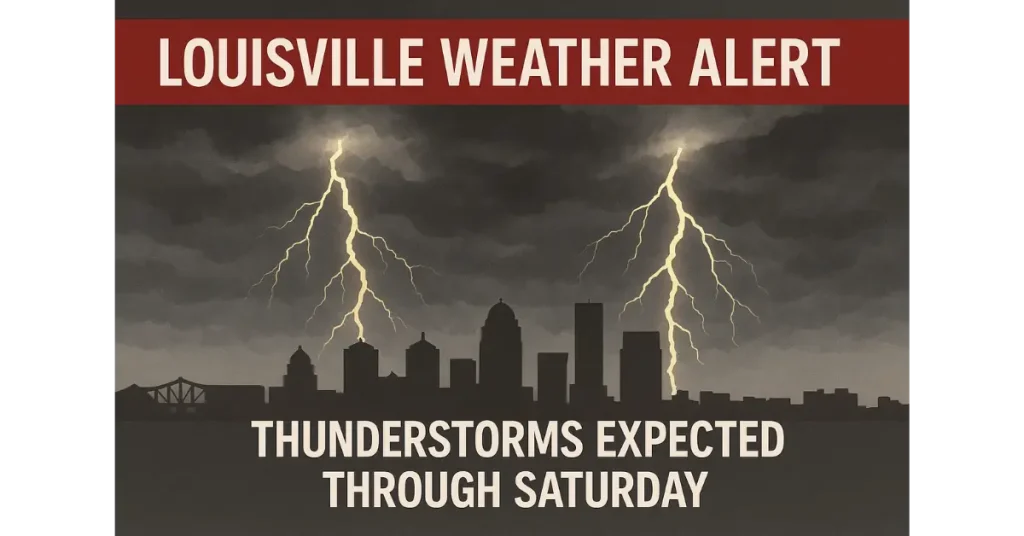If you’re in or around Louisville this week, it’s time to prepare for a wet and stormy stretch. The Louisville weather forecast indicates several days of thunderstorms sweeping through the region, affecting not only Kentucky but also Southern Indiana storms areas. From lightning strikes to heavy downpours, this weather pattern is set to leave a lasting impression through Saturday, prompting critical advisories from the National Weather Service Louisville.
Whether you live in the heart of the city or the surrounding counties, understanding what’s coming, how to stay safe, and what to expect from the Kentucky weather this week is key. Let’s unpack the details and provide helpful insights for navigating the upcoming weather.
Current Weather Conditions: What the Radar Shows
According to the latest updates from Indiana weather radar and Kentucky’s weather monitoring stations, a low-pressure system is moving into the Ohio Valley, fueling unstable air conditions perfect for thunderstorm development.
- Storm clusters have been seen developing southwest of Louisville, moving steadily northeast.
- Radar images show typical summer storm cells—intense with rapid growth and occasional rotation.
- These storms are expected to bring bursts of heavy rainfall, impacting the Louisville rain forecast through multiple periods over the next few days.
Local meteorologists emphasize that while some storm cells might be short-lived, others may linger longer, increasing risks for flooding in vulnerable locations.
What to Expect: Daily Storm Forecast Louisville Breakdown
The daily storm forecast Louisville breaks down as follows:
| Day | Expected Weather | Key Details |
|---|---|---|
| Thursday | Scattered thunderstorms | High chance of lightning and brief heavy rain |
| Friday | More widespread storms | Possible severe weather, including gusty winds |
| Saturday | Lingering showers & storms | Risk of localized flooding |
In particular, Thursday night through Friday afternoon are expected to be the most intense periods, according to both the National Weather Service Louisville and regional weather forecasters.
Louisville Thunderstorm Alert: Severe Weather Update
The Louisville thunderstorm alert currently in effect raises concern for:
- Lightning strikes: Dangerous for outdoor activities and a fire hazard in dry areas.
- Heavy rainfall: Some areas could see quick accumulations, leading to temporary flash flooding.
- Gusty winds: Downed branches, power interruptions, and creating hazardous driving conditions.
Residents should heed warnings and be ready to seek shelter when thunder is heard, as per the classic rule: “When thunder roars, go indoors.”
The Louisville severe weather update also notes that while tornadoes are not currently forecasted, rapid changes in storm dynamics mean that vigilance is necessary.
Preparing for the Storms: Safety Tips and Practical Advice
Being weather-aware means being prepared. Here are thoughtful protective measures for Louisville residents and those in nearby regions:
- Monitor local forecasts and alerts: Use apps, local news, or the National Weather Service updates to stay informed.
- Secure outdoor belongings: Loose items can become projectiles during gusty winds.
- Avoid unnecessary travel during thunderstorms: Flooded roads and low visibility can be life-threatening.
- Have a safety kit ready: Flashlights, batteries, bottled water, and a first-aid kit are basics that help during power outages.
- Unplug electronics: Lightning can cause damaging power surges.
- Stay indoors during lightning: Do not use corded phones or plugged-in appliances.
Additionally, families with children or elderly members should review emergency plans and know where to take shelter.
Broader Regional Impact: Southern Indiana Storms and Beyond
While Louisville faces immediate concerns, the Southern Indiana storms are not to be overlooked. Counties just north of the Ohio River are already tracking heavier precipitation on the radar and forecasting similar storm activity.
- Residents in Clark, Floyd, and Harrison counties should expect gusty winds and intermittent heavy rain.
- Some localized flooding might occur in low-lying areas, especially near rivers and drainage basins.
- Indiana’s meteorologists are working closely with Louisville’s National Weather Service office to coordinate alerts and emergency responses.
This regional spread underscores the interconnectedness of weather systems affecting the Ohio Valley, reminding us that preparedness should be a community effort.
The Science Behind Kentucky Lightning and Rainfall
Summer months in Kentucky typically bring humid and unstable atmospheric conditions, producing thunderstorms. But why is this week’s weather pattern particularly active?
- A moist air mass from the Gulf of Mexico is pushing northward, saturating the atmosphere.
- In combination with an approaching cold front, this creates instability—warm moist air rises rapidly and condenses, producing clouds and storms.
- Lightning forms as strong wind currents cause different parts of clouds to become electrically charged.
- Rainfall in these thunderstorms can be heavy due to the moisture content, sometimes falling at rates exceeding 1 inch per hour in downpours.
Understanding these meteorological factors helps residents appreciate the seriousness of such weather events and respect safety precautions.
Two Perspectives on Louisville’s Storm Season
The Early Bird View: Routine Summer Patterns
Some Kentuckians take these storms in stride, seeing them as typical for July:
- “We get thunderstorms every year around this time. It’s just part of living here,” says a Louisville native.
- This perspective emphasizes preparedness but remains calm, knowing storms also help keep the summer heat in check.
The More Concerned Outlook: Changing Patterns and Impact
Others are more guarded, pointing to increased occurrences of severe weather in recent years:
- Stronger storms bring greater risks for flooding and property damage.
- Increased public awareness and improved alert systems mitigate loss but can’t eliminate the risks entirely.
- Climate patterns causing more intense lightning and rainfall demand greater vigilance from residents and city officials alike.
Both views highlight the balance between knowing what’s normal and adapting to evolving realities.
Monitoring Tools: How to Stay Updated
To stay ahead of rapidly changing conditions, use these resources:
- National Weather Service Louisville website: Real-time alerts and forecasts
- Louisville metro government social media: Updates on road closures or emergency services
- Weather apps: Localized radar and push notifications tailor-made for your area
- Local news channels and radio: Trusted sources for live updates and detailed reports
Utilizing these tools can make all the difference on stormy days.
In Conclusion: Storm Season Calls for Awareness and Preparedness
As Louisville braces itself for the next few days of thunderstorms, the growing chorus of voices—from the National Weather Service Louisville to local communities—urges vigilance. This stretch of stormy weather affects not just the urban center, but also Southern Indiana storms and beyond, weaving a complex weather tapestry that calls for respect and readiness.
The key takeaways are straightforward:
- Expect lightning, heavy rain, and gusty winds daily through Saturday.
- Prioritize safety by staying indoors during storms and monitoring weather updates actively.
- Be prepared for potential power outages or flooding in vulnerable areas.
- Recognize that these weather conditions, while common in summer, can be intense and disruptive, so plan accordingly.
Speaking from experience, an informed and prepared community weathers storms better—both literally and figuratively. While inclement weather might slow us down, it doesn’t have to stop us. This alert is not just about caution; it’s about taking care of ourselves and our neighbours as we ride out the elements together.
Stay safe, Louisville—and keep that radar app handy.


